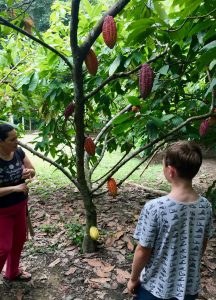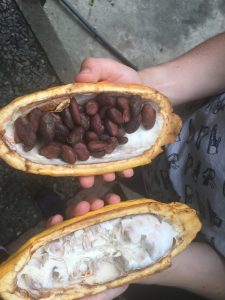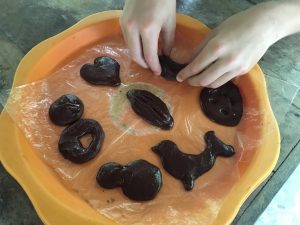By Brae
To get to Paso del mango, you can not go all the way by car, so we got there by motorbike. We took a taxi to a police station at the foot of a mountain, then we ordered four motorbikes and set off up the mountain.

We had no helmets and our huge backpacks were balanced precariously on the front of the bike as we set off up the road for the half hour long journey. When I say road it was actually a dirty track and it was extremely bumpy and rocky like a cliff. I was just getting used to all the bumps when my driver took our his phone and started playing candy crush!!! I know someone driving up a steep dirt track one handed with a mobile phone in one hand sounds crazy but he really did play it! I think my mum and dad were pleased that they didn’t know about this until I got there safely. On the way back my driver’s phone rung and he answered it, stuck it in his helmet and started talking to the person on the phone, Oren’s driver was listening to music inside his helmet on the way there as well occasionally getting it out to switch songs. I found out that it was not unusual for motorbike drivers to go on their phones while they were driving, in fact they did it most of the time! They must have great skill, although as my driver made the sign of a cross after we arrived maybe my driver was also relieved we made it!
In Colombia motorbike taxi drivers don’t drive on the left, they drive on the right, apart from when some of them drive on the left of course, or in the middle sometimes!!! Pretty much whenever they feel like driving on the left or in the middle they drive there.
We were very surprised by this driving but we also noticed the skill of the drivers: weaving in and out of the rocks at speed up hills and down them! It’s not only on motorbikes that you get driving like that. Some taxi drivers on the coast are nearly as reckless as the motorbike drivers. They go fast and change lanes into the smallest gap. Another thing that we noticed is the amount of beeping that goes on. You have to listen carefully to distinguish between the get out of my way beep, the hurry up the light is about to go green beep, the beep for do you want a taxi and a general beep for the fun of it. There are so many horns going off you can’t even tell whether it is your taxi driver beeping or being beeped at! In a traffic jam it is the worst though.
The other thing that we’d forgotten about was the ‘how many people can you get in a car’ game. When there is a big group of people and you are wondering how many cars or taxis you will need to get to your destination, I can tell you that no matter how many of you there are, the answer will always be one! It is strange how much of a surprise these things can be when you are used to things being a certain way.
 red, orange, yellow, green and purple. Our guide said that inside these pods were the cacao beans that made chocolate, and the colour of the pod depended on how ripe it was and the type of tree. She said that there were 2 types of tree: original and mixed. There were two types of original trees; one with yellow pods for when it was ripe and green when it wasn’t. The other original tree had orange and red for ripe pods and purple for unripe ones. The mixed trees included both types, so they had all five colours on the tree, but they were cultivated differently and made more pods. These trees looked like a rainbow and it was amazing to see that the pods grew straight out of the tree trunk. I really don’t think there is any other crop that looks anything like cacao, and we were already fascinated.
red, orange, yellow, green and purple. Our guide said that inside these pods were the cacao beans that made chocolate, and the colour of the pod depended on how ripe it was and the type of tree. She said that there were 2 types of tree: original and mixed. There were two types of original trees; one with yellow pods for when it was ripe and green when it wasn’t. The other original tree had orange and red for ripe pods and purple for unripe ones. The mixed trees included both types, so they had all five colours on the tree, but they were cultivated differently and made more pods. These trees looked like a rainbow and it was amazing to see that the pods grew straight out of the tree trunk. I really don’t think there is any other crop that looks anything like cacao, and we were already fascinated.  Our guide chopped one of the pods off and cut it open with her machete. Inside we were extremely surprised to see white seeds instead of brown. She said that we couldn’t eat the seeds but we could eat the soft coating around the outside. We all took a bit and it was so sweet. It tasted like a tropical fruit that had been grown only to eat on its own, not to make chocolate. It was so delicious that we had to have more until we’d eaten nearly half the pod. Beneath the white coating there was a pale brown seed that looked a bit like an almond and that was the bit that was made into chocolate. When the seeds had been removed from the pod, they were put in a bag to ferment and then put out in the sun to dry.
Our guide chopped one of the pods off and cut it open with her machete. Inside we were extremely surprised to see white seeds instead of brown. She said that we couldn’t eat the seeds but we could eat the soft coating around the outside. We all took a bit and it was so sweet. It tasted like a tropical fruit that had been grown only to eat on its own, not to make chocolate. It was so delicious that we had to have more until we’d eaten nearly half the pod. Beneath the white coating there was a pale brown seed that looked a bit like an almond and that was the bit that was made into chocolate. When the seeds had been removed from the pod, they were put in a bag to ferment and then put out in the sun to dry.  Finally, they were spread out on a platform to dry. The platform had a sliding roof over it so the people on the farm could shut the roof when it rained. It was really important that the seeds didn’t get wet at any point in the process.
Finally, they were spread out on a platform to dry. The platform had a sliding roof over it so the people on the farm could shut the roof when it rained. It was really important that the seeds didn’t get wet at any point in the process.  The next step was breaking off the skin around the bean and we were put to work doing that. You were allowed to try the inner part but it was very bitter. When all the skins had been thrown into the compost we put the remaining part of the seed into a mill or grinder where you had to turn a handle to make a kind of chocolate paste. This is when it turns from cacao to chocolate. Finally, you added sugar and they also added cinnamon which was a family secret, shhh 🤫 ! At this point, we were given some of the chocolate and we were told to make a shape out of it. I made an empanada, Brae made a smily face, Dad made a snowman and Mum made a seal. We were then allowed to eat them, which I was very happy about.
The next step was breaking off the skin around the bean and we were put to work doing that. You were allowed to try the inner part but it was very bitter. When all the skins had been thrown into the compost we put the remaining part of the seed into a mill or grinder where you had to turn a handle to make a kind of chocolate paste. This is when it turns from cacao to chocolate. Finally, you added sugar and they also added cinnamon which was a family secret, shhh 🤫 ! At this point, we were given some of the chocolate and we were told to make a shape out of it. I made an empanada, Brae made a smily face, Dad made a snowman and Mum made a seal. We were then allowed to eat them, which I was very happy about.
 Just when we thought it couldn’t get any more interesting, our guide put some of the paste aside and mixed it with hot water to create a smooth paste which she put on our faces – a chocolate face mask! While we were letting the mask have its effect we had some delicious hot chocolate and got some homemade chocolate and orange brownie. I think you will realise by now that this was my kind of tour, and it was another day in Colombia that I will never forget!
Just when we thought it couldn’t get any more interesting, our guide put some of the paste aside and mixed it with hot water to create a smooth paste which she put on our faces – a chocolate face mask! While we were letting the mask have its effect we had some delicious hot chocolate and got some homemade chocolate and orange brownie. I think you will realise by now that this was my kind of tour, and it was another day in Colombia that I will never forget!